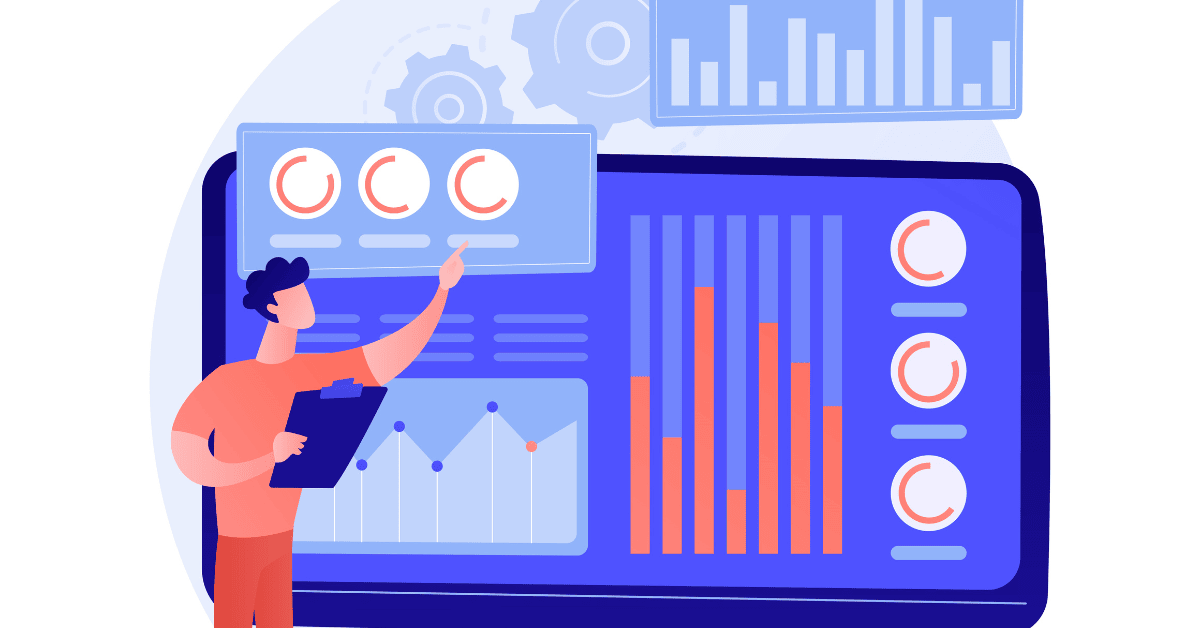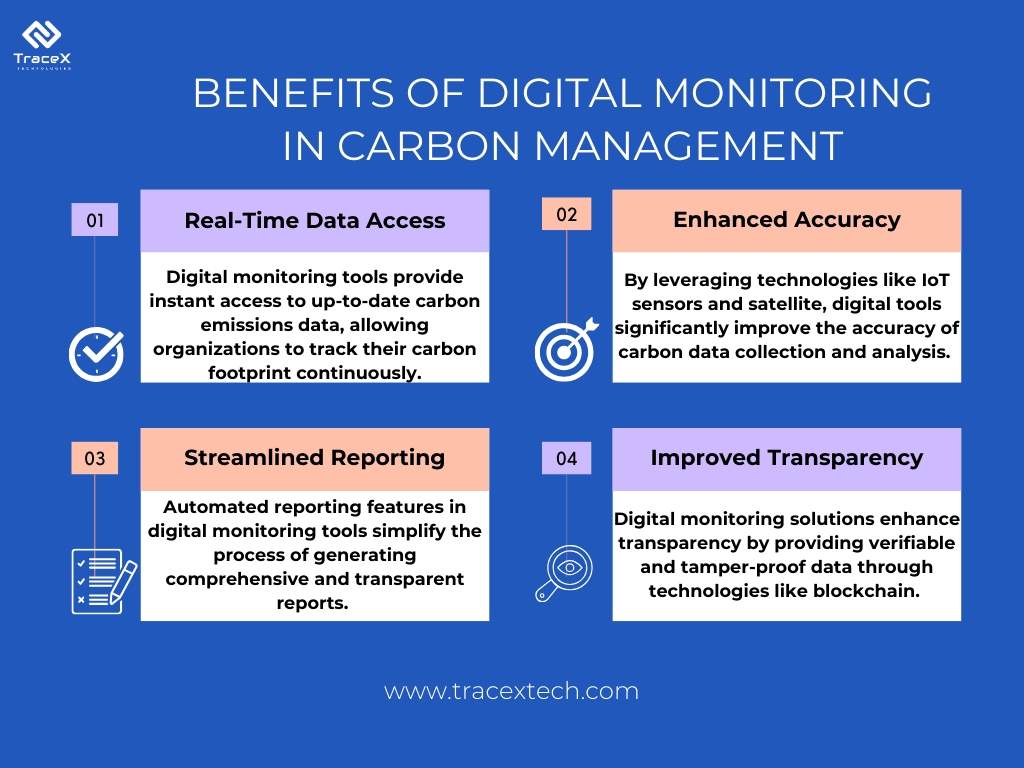Contact: +91 99725 24322 |
Menu
Menu
Quick summary: Discover how digital monitoring is revolutionizing carbon management with cutting-edge technologies like IoT, AI, and blockchain. Explore how these tools enhance accuracy, streamline reporting, and drive effective sustainability strategies. Learn why embracing digital solutions is crucial for achieving your Net Zero goals and leading the way in environmental stewardship.

Are you relying on manual data collection and error-prone spreadsheets to manage carbon emissions? It is critical for organizations to look into accurately track their emissions, meet regulatory requirements, and make informed decisions about their sustainability strategies. The role of digital monitoring in carbon management has never been more crucial. It offers unprecedented accuracy and transparency in managing carbon emissions.
Carbon tracking and monitoring tools are revolutionizing the way we manage carbon emissions. Today, advanced technologies like IoT sensors, satellite imagery, and blockchain are enabling real-time monitoring and transparent reporting of carbon data. A powerful tool that not only tracks your carbon footprint in real-time but also provides actionable insights to drive your sustainability goals forward.
Digital monitoring is about more than just collecting data – it’s about building trust and demonstrating accountability. According to WEF, innovative digital solutions are fast evolving as a new international carbon market nears reality.
Digital monitoring in carbon management is like having a high-tech guide that helps you navigate the complex world of carbon emissions and sustainability. At its core, digital monitoring involves using advanced technologies to track, measure, and manage your carbon footprint with unparalleled precision. This approach is crucial because it provides the clarity and accountability needed to meet climate goals and demonstrate genuine commitment to environmental stewardship.
Imagine a network of smart sensors scattered across your operations, each one quietly gathering data about carbon emissions, energy use, and environmental conditions. These IoT devices feed real-time information into a central system, allowing you to monitor emissions as they happen and quickly address any issues.
Once the data is collected, AI steps in to make sense of it. Through sophisticated algorithms and machine learning, AI analyzes the data, identifies patterns, and predicts future trends. This not only helps in understanding current emissions but also in forecasting and mitigating future impacts.
In a world where data integrity is paramount, blockchain technology ensures that your carbon data remains unaltered and transparent. By creating an immutable record of all transactions and measurements, blockchain helps to build trust and verify that your carbon management efforts are both accurate and honest.
The benefits of digital monitoring are transformative. It enhances accuracy by providing detailed and real-time insights into your carbon emissions. It improves reporting by automating data collection and analysis, making it easier to generate comprehensive reports. And perhaps most importantly, it increases transparency, allowing stakeholders to see exactly how and where emissions are being managed, which builds credibility and supports your sustainability goals.
In addition to these technological advancements, digital monitoring supports sustainable carbon management practices by enabling continuous improvement and adaptive strategies. This ensures that your carbon management efforts not only comply with regulations but also drive long-term environmental benefits.
Digital monitoring solutions are built on a foundation of essential components that work together to provide a clear, accurate, and actionable picture of your carbon emissions.
Together, these components create a robust framework for managing and reducing carbon emissions effectively, making digital monitoring an indispensable tool in achieving your sustainability goals.
Successfully integrating digital MRV (Measurement, Reporting, and Verification) solutions into your carbon management strategy involves several thoughtful steps and best practices.
By following these steps and best practices, you can effectively implement digital MRV solutions and enhance your carbon management efforts, making a significant impact on your sustainability goals.
Initially, carbon data management tools were designed primarily for annual measurement, monitoring, and reporting of carbon emissions. Their main purpose was to provide data for both internal and external stakeholders. This typically involved collecting first-party carbon data and inputting it into a standardized system for aggregation. These tools were effective for once-a-year reporting and didn’t require real-time data, making the process relatively straightforward. However, this approach had limitations in more complex scenarios, as it often lacked the detailed insights needed for organizations to accurately track their Net Zero progress.
As the need for real-time decarbonization data has grown, so has the demand for more comprehensive carbon data management solutions. These advanced tools are now essential for managing and aggregating complex decarbonization data, providing a fuller picture of an organization’s progress toward its sustainability goals.
The growing need for Digital carbon monitoring for net zero has led to a surge in innovative solutions. These modern tools enable a data-first approach to decarbonization, offering capabilities to manage and analyze real-time data, ensuring that organizations stay on track with their sustainability efforts.
These tools are essential for tracking and reporting greenhouse gas emissions. They help organizations comply with regulatory requirements and set effective reduction targets by providing accurate emissions data and insights.
These solutions allow organizations to monitor and control their energy consumption in real time. By analyzing energy usage, they help identify opportunities for energy savings and efficiency improvements, contributing to overall carbon reduction.
These platforms offer a way for individuals and businesses to compensate for their carbon footprint by investing in carbon emission reduction strategies through projects that reduce or remove greenhouse gases. Examples include initiatives in reforestation and renewable energy, which help balance out emissions and support broader environmental goals.
By incorporating these advanced digital tools, organizations can better manage complex carbon data, streamline their decarbonization efforts. Carbon offsetting and monitoring is crucial to make progress toward achieving their Net Zero objectives.
While digital tools have revolutionized carbon data management, they come with their own set of challenges.
But with the right strategy and support, these obstacles can be overcome. By partnering with experts and leveraging best practices, companies can harness the full potential of digital monitoring to drive their sustainability agenda forward.

The TraceX Digital MRV platform (Measurement, Reporting, and Verification) stands out as a cutting-edge solution for managing carbon data with unparalleled precision and efficiency. Designed to address the complexities of modern carbon management, TraceX leverages advanced technologies such as blockchain, IoT, and satellite imagery to provide real-time, accurate insights into carbon emissions and sustainability efforts. The platform excels in aggregating and analyzing vast amounts of data, ensuring that organizations can track their carbon footprint with exceptional clarity. By offering robust features for data collection, verification, and reporting, TraceX not only simplifies compliance with regulatory requirements but also enhances transparency and trust across the supply chain. Its intuitive interface and comprehensive capabilities empower businesses to make informed decisions, optimize their carbon management strategies, and accelerate their journey toward Net Zero goals.
As we move forward, it’s clear that digital monitoring will be a key driver of progress in the fight against climate change. By providing the data, insights, and transparency needed to tackle emissions reduction, these innovative tools are empowering organizations to make a real and lasting impact. The time to act is now – let’s embrace the power of digital monitoring and build a more sustainable future together.
